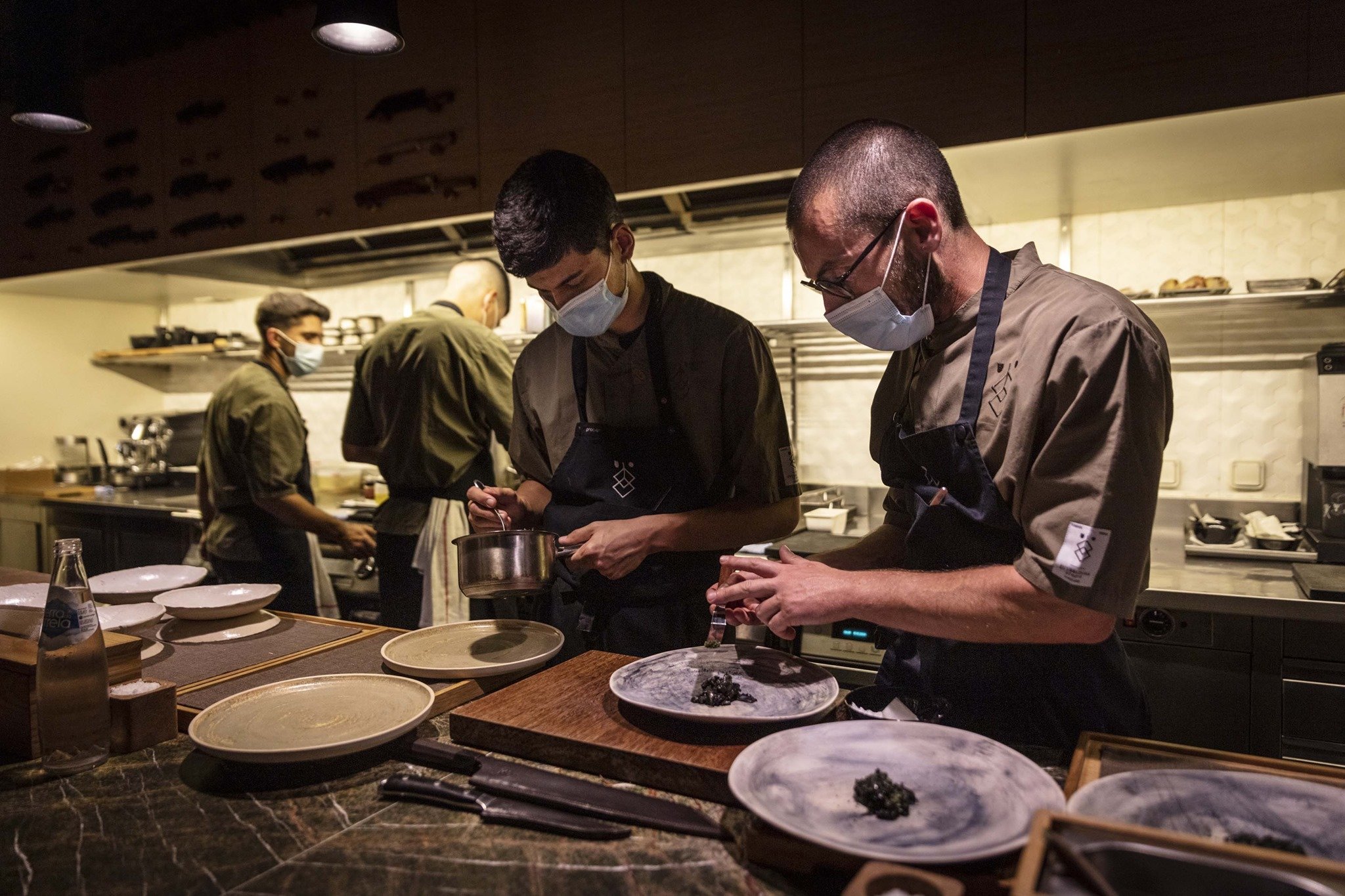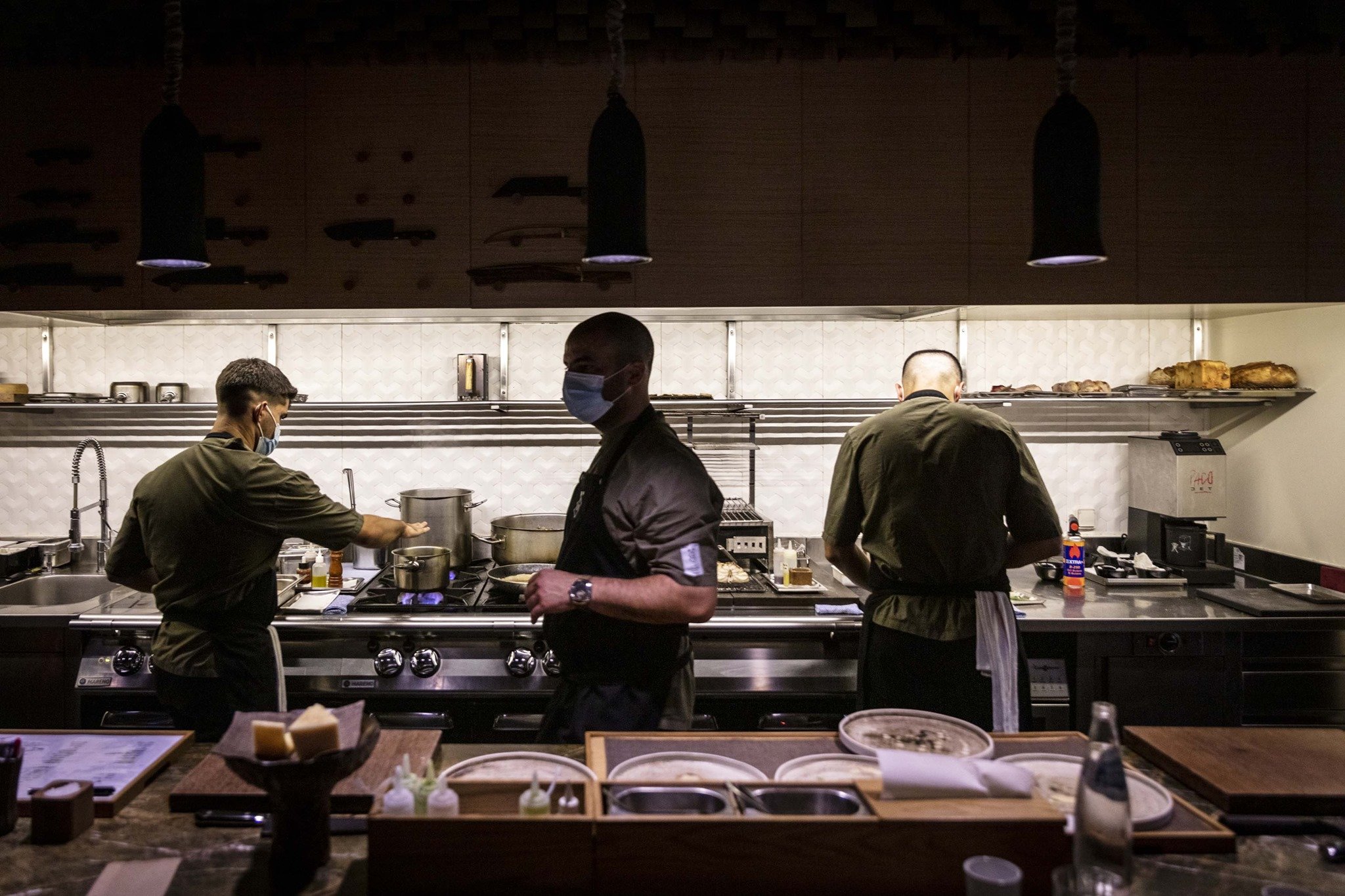Euskalduna Studio, Porto, Portugal
Last Visit: November 2023
The very first of our articles on culinary exploration takes us to a place that is much more known for its food than its cocktails, but not necessarily its drinking culture in general. In the shadow of Portugal’s colonial past, with sun and Atlantic winds, lies Porto, a city that we have already gotten to know a bit in our article about the Royal Cocktail Club. I don't think I need to tell you that finding good food in a city like that is as easy as finding good wine. Much easier than a mixed drink, as stated. That however poses a challenge in itself: Where to go as a first time visitor to the city? Of course one has an idea about Portuguese cuisine, and we have also previously written about vivid presentations (such as this event), but local will always be another level.
Porto, at the time of visit, had two restaurants with two Michelin stars each, as well as some with one star, some recommendations and the absolute plethora of places that were simply known for being exceptional when it comes to a particular type of local delicacy or dish. When comparing the menus, the philosophy and the locations, my choice was Euskalduna Studio, awarded one star. Let me be clear, that I wasn't just hunting for the most exclusive or pricey place, but something that would best distill Porto as a city and give me the opportunity to learn more about the country. Euskalduna Studio has exactly the setting needed for that. It features the layout of a Japanese Sushi restaurant, in the Omakase style of sitting across from the cooks, who will prepare every dish in front of the guests, which are limited in number.
The other, if you want to call them, big names, such as Casa de Chá da Boa Nova or Pedro Lemos (one of which has also gained notoriety as a place Antony Bourdain visited on his trip to Porto), simply seemed too busy, too big, to give me the most essential impression. Euskalduna Studio does not get its Japanese inspiration by accident. The chef has trained there and is incorporating many elements of Japanese cooking into his menus. It is also not uncommon to still find connections between Portugal and Japan even many centuries after their historic ties, luckily now with friendlier intentions.



Copyright: Euskalduna Studio
A serene, intimate atmosphere welcomes guests at Euskalduna Studio, past some regular tables for the evening service, you enter the kitchen with its counter and small but thoughtfully comfortable chairs, lined up next to each other. This feels like fine dining, which is a good thing. I of course arrived early, simply to observe the front door, and it was fascinating to see that a lot of the ingredients were brought in fresh right before service, such as the homemade bread that is prepared a few doors down the street at their own bakery.
The Omakase menu features a lot of smaller sized dishes, which is another advantage for me, as I get to see more variety and can still go for a full, late dinner. We will not go through every dish, step by step, as that would take away from the experience as a whole, and it would also not be fair to the restaurant itself, who values the closeness of the dining experience. They do not post full descriptions or pictures of the courses. For the same reason I did not take any pictures of the food, only of the wine for reference, after asking the staff if I may do so. Taking pictures on a kitchen counter, next to only a handful of other guests, would have been rude to their experience as well and diminishing it. I was happy to see that there was a range of guests, that was not at all the typical ‘law firm dinner crowd’. A Japanese couple and an American couple were joining me for this afternoon.
Copyright: Euskalduna Studio
Each menu has a seasonal or topical theme, that adds another level of complexity to the two other themes: Porto and Japan. In my case, it was citrus fruits, meaning each dish had a different kind of citrus in it. That of course works very well, as both cuisines each utilize citrus quite a bit in their cooking. Not coincidentally, both also heavily rely on fish. To really visualize that point, the team brings out a basket full of fruit in all shapes and sizes out and puts it in front of the guests. The menu is not published in advance but always has 10 courses, with some added surprises, appetizers, and breaks. As a pairing I opted for a modified wine pairing, as I wanted to also see what they would come up with for non-alcoholic pairings or interesting port wines, and it was a brilliant decision. The sommelier took all his time in providing some great and creative choices. If you are reading this as a bar nerd, here are some parts for you, that make reading this article worth it: Euskalduna, as a Michelin restaurant can actually make cocktails, they have some single malts as well as Empirical Spirits. After spotting these in the corner of the open kitchen I asked the sommelier about it, and he said that in the rare cases, where a customer absolutely does not like wine, or wants a completely different taste experience for a dish, they can also do drinks. I also received some amazing tips for bars to visit from him, that I was not expecting to hear about at 'just a restaurant'. It is the common misconception that even the most famous 3-Star restaurants can not compare to a classic bar, but that is simply not true.
The level of understanding about the combination of drink and food for a Michelin starred sommelier is something many, many bartenders could learn from. Starting with the 2017 Niepoort Bairrada Gonçalves Faria Branco Quinta de Baixo it is already obvious that such a young and more multidimensional restaurant would also go for more ‘modern’ Portuguese wine. Aside from my personal favorites, that being Port, this was my highlight, with great subtlety in its smoky minerality and freshness for starting the courses. The 2015 Pormenor Douro Trilho next added exceptional dry minerality, while leaving enough room for the citrusy dishes to balance with acidity. It is one of those wines that can elevate grilled fish, beyond the traditional Vinho Verde, that Portugal is famous for. 2019 Justino's Madeira Verdelho 10 Years Old led into the desserts, with the unique high-seas influence of the island setting it apart from the classic fortified wines. After talking to the Sommelier I also added J.H. Andresen 10 Year Old White Port as we talked about the lack of appreciation for white ports. A beautiful floral and rich spirit, that, as it was served by my request, did not correspond with any dish. There was also an intermission in the form of a freshly brewed tea, to cleanse the palate, which I always appreciate.
Ingredients for the courses went light and cleansing, with a lot more focus on the citrus, on freshness, on saltiness from the sea and light textures. Some dishes were inspired by a certain technique, for example the grilling of meats and fish, as in variations of Portugal’s famous Bacalhau, which can take on beautiful aroma based on the climate and the place. This is replicated in the kitchen on the grill with the addition of wood and herbal smoke. Others were inspired by the once vast and exuberant Portuguese empire, with a deep-sea squid that is served in a sauce of its own ink. Every type of seafood from caviar to clams is incorporated and as is expected at that level, there is an emphasis on sustainability, in which most parts of any ingredient are used. Sometimes an ingredient from a previous round of service comes back as the base for a stew in the current one. Some dishes go back to the nostalgia and the humbleness of people who simply love the food that is on the table, with homemade bread, dipped in a sweet, umami sauce. This was probably my favorite dish, as I absolutely adore well-made bread, an art that is often lost even in the best kitchens. Paired with something that reminds me of deepest port wines it created the impression of not just bread with jam that I believe every European can relate to, it also reminded me of my most well-loved Scotch whiskies, such as 30-year-old, sherry-matured Highland Park.
Copyright: Euskalduna Studio
The perfect atmosphere was noticeable in one particular moment. A dish was made with Japanese katsuobushi, a base for many soups in Japanese cooking. The Japanese gentleman, sitting next to me, mentioned to the cook, who was always right in front of the guests and absolutely eager to answer any questions, that as a kid he used to shave these using a traditional Japanese kitchen appliance, called a kezuriki. The cook then brought the vintage one that they use at the restaurant to show to all the guests and with that everyone had learned something new, including the cook, who got instructed on the proper traditional technique from someone who had been doing it for decades in Japan.
The journey showcased everything there was to showcase, from aged meats and fish, slightly spicy Asian flavors, sun dried lemons to rare ingredients. Just by the food itself, I think Euskalduna sits at the right level, somewhere reaching for that second star, firmly above the level of one. Sometimes the dishes 'battle' a bit for what they want to do, express the flavor of seasoning, or show the quality of the ingredient, something of course that Japanese fine dining can also struggle with. Nevertheless, I am more than happy that I opted for this experience and not the more straightforward high-end restaurants. The atmosphere was absolutely perfect, the service outstanding, the ability to ask questions amazing. And all that by the entire staff which was there, not only the head chef, who had no direct supervision over his team, as they were the people running the show.
/jf










